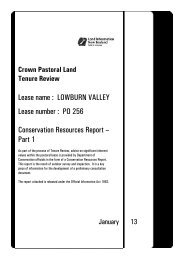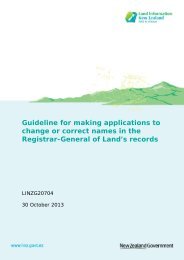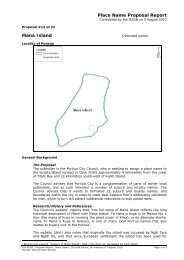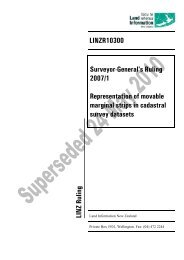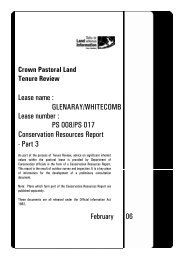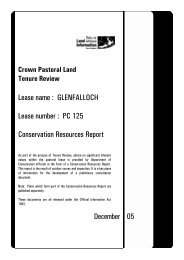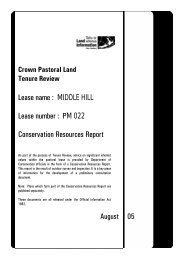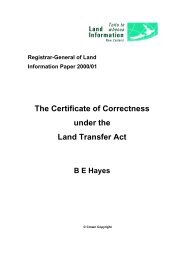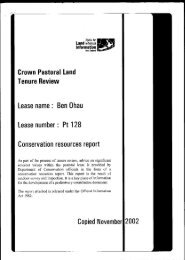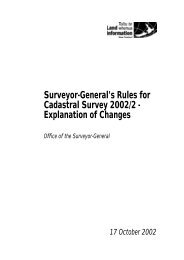Crown Pastoral-Tenure Review-Lake Hawea-Conservation ...
Crown Pastoral-Tenure Review-Lake Hawea-Conservation ...
Crown Pastoral-Tenure Review-Lake Hawea-Conservation ...
You also want an ePaper? Increase the reach of your titles
YUMPU automatically turns print PDFs into web optimized ePapers that Google loves.
RELEASED UNDER THE OFFICIAL INFORMATION ACT<br />
-Breast Hill, site 6. This is the only known site in which the completely new carabid species<br />
Megadromus n.sp. 2 is found.<br />
-Much of the south-eastern face from the Timaru River to the ridge line is considered<br />
significant. This includes a large amount of high country tussock (sites 6, 7, 8 and 9) with a<br />
healthy invertebrate fauna including the new spider species in the genus Gasparia. The<br />
chirping cicada, Amphipsalta strepitans, was found in kanuka shrubland above Timaru River<br />
and this species indicates good quality rocky-shrubland habitat. It was not possible to sample<br />
the beech forest remnants in this area but, based on what was found in other beech areas, they<br />
are likely to have diverse and interesting invertebrate faunas.<br />
2.5.2 Herpetofauna:<br />
“Site locations of rare and endangered herpetofauna are recorded in the original report.<br />
Herpetofauna of this nature is at risk of illegal activities including damage and removal<br />
through unlawful interference and disturbance. Accordingly, information regarding<br />
the locations of any such herpetofauna has been deleted from this version of the report.<br />
The Department of <strong>Conservation</strong> has put in place mechanisms to ensure that such<br />
information can be released for genuine scientific and research purposes. Please<br />
contact the Department of <strong>Conservation</strong> directly to determine whether the information<br />
can be released.”<br />
Inspections for the purpose of looking at lizard values were carried out on the 9 – 12<br />
December 2002 and again on the 13 February 2003.<br />
Three species of lizards were found, McCann’s Skink (Oligosoma maccanni) and Common<br />
Gecko (Hoplodactylus ‘Southern Alps’[Hitchmough, 1997]) occurs in rock outcrops up to<br />
1380m altitude, and Cryptic Skink (O. inconspicuum) was found between 900 – 1670m asl.<br />
Very few lizards were found on the east and north facing slopes overlooking Branch Creek or<br />
the Timaru River catchment, most specimens being found on the alpine ridge tops and the<br />
various branches of Breast Creek. Common Gecko were extremely abundant in the creek<br />
gorge.<br />
A fourth species, the Grand Skink (O.grande), is present in bluffs above the main branch of<br />
Breast Creek. They were not observed during the December 2002 inspection due to the cold<br />
weather. Several had been previously seen in April 1998 and a total of 26 were seen during<br />
one day in February 2002. A further search in February 2003 found 8 Grand Skinks in a<br />
previously known location with little effort.<br />
Significance of Herpetofauna:<br />
The three species found during the December 2002 inspection are relatively widespread and<br />
common in the Otago and/or Canterbury areas. Both Cryptic Skink and Common Gecko are<br />
nearing their range limits (north and south respectively) in the <strong>Hawea</strong> area.<br />
The Grand Skink is classified as an ‘Acutely Threatened’ – ‘Nationally Endangered’ species<br />
(Hitchmough, 2002). It was once widespread in Otago, but has declined considerably, today<br />
being known from only two areas: in the Lindis/<strong>Hawea</strong> district and in the Macraes Flat<br />
DOCDM-372005 <strong>Lake</strong> <strong>Hawea</strong> CRR - Info.doc 22



